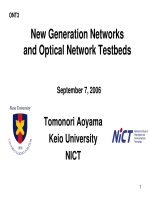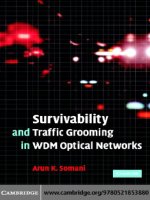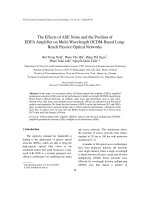Springer optical networks and technologies 2005
Bạn đang xem bản rút gọn của tài liệu. Xem và tải ngay bản đầy đủ của tài liệu tại đây (25.77 MB, 631 trang )
OPTICAL NETWORKS AND
TECHNOLOGIES
IFIP – The International Federation for Information Processing
IFIP was founded in 1960 under the auspices of UNESCO, following the First World Computer
Congress held in Paris the previous year. An umbrella organization for societies working in
information processing, IFIP’s aim is two-fold: to support information processing within its
member countries and to encourage technology transfer to developing nations. As its mission
statement clearly states,
IFIP’s mission is to be the leading, truly international, apolitical organization
which encourages and assists in the development, exploitation and application
of information technology for the benefit of all people.
IFIP is a non-profitmaking organization, run almost solely by 2500 volunteers. It operates
through a number of technical committees, which organize events and publications. IFIP’s
events range from an international congress to local seminars, but the most important are:
The IFIP World Computer Congress, held every second year;
Open conferences;
Working conferences.
The flagship event is the IFIP World Computer Congress, at which both invited and contributed
papers are presented. Contributed papers are rigorously refereed and the rejection rate is high.
As with the Congress, participation in the open conferences is open to all and papers may be
invited or submitted. Again, submitted papers are stringently refereed.
The working conferences are structured differently. They are usually run by a working group
and attendance is small and by invitation only. Their purpose is to create an atmosphere
conducive to innovation and development. Refereeing is less rigorous and papers are subjected
to extensive group discussion.
Publications arising from IFIP events vary. The papers presented at the IFIP World Computer
Congress and at open conferences are published as conference proceedings, while the results of
the working conferences are often published as collections of selected and edited papers.
Any national society whose primary activity is in information may apply to become a full
member of IFIP, although full membership is restricted to one society per country. Full members
are entitled to vote at the annual General Assembly, National societies preferring a less
committed involvement may apply for associate or corresponding membership. Associate
members enjoy the same benefits as full members, but without voting rights. Corresponding
members are not represented in IFIP bodies. Affiliated membership is open to non-national
societies, and individual and honorary membership schemes are also offered.
OPTICAL NETWORKS AND
TECHNOLOGIES
IFIP TC6 / WG6.10 First Optical Networks &
Technologies Conference (OpNeTec),
October 18-20, 2004, Pisa, Italy
Edited by
KEN-ICHI KITAYAMA
Department of Electronics and Information Systems
Osaka University, Japan
FRANCESCO MASETTI-PLACCI
Alcatel
Vimercate, Italy
GIANCARLO PRATI
Consorzio Nazionale Interuniversitario per le Telecomunicazioni – CNIT, Pisa, Italy
Scuola Superiore Sant’Anna, Pisa, Italy
Springer
eBook ISBN:
Print ISBN:
0-387-23178-1
0-387-23177-3
©2005 Springer Science + Business Media, Inc.
Print ©2005 by International Federation for Information Processing.
Boston
All rights reserved
No part of this eBook may be reproduced or transmitted in any form or by any means, electronic,
mechanical, recording, or otherwise, without written consent from the Publisher
Created in the United States of America
Visit Springer's eBookstore at:
and the Springer Global Website Online at:
Contents
Preface
xv
Acknowledgments
xvii
Committees
xix
Perspectives on Optical Networks and Technologies
1
Developments in Optical Seamless Networks
Andrea Spaccapietra and Giovanni Razzetta (invited paper)
3
Cinema-class Digital Content Distribution via Optical Networks
11
Tetsuro Fujii, Kazuhiro Shirakawa, Mitsuru Nomura, and
Takahiro Yamaguchi (invited paper)
Next Generation Networks – a Vision of Network Evolution
Howard Green and Pierpaolo Ghiggino
19
An Overview of Key Technologies for the Next Generation Networks
Howard Green and Pierpaolo Ghiggino
31
PART A1: Optical Packet Switching / Optical Burst Switching
45
Guaranteeing Seamless End-to-End QoS in OBS Networks
47
Maurizio Casoni, Maria Luisa Merani, Alessio Giorgetti, Luca
Valcarenghi and Piero Castoldi
vi
A Framework for the Analysis of Delay Jitter in Optical Packet Switched
55
Networks
F. Callegati, W. Cerroni, G. Muretto, C. Raffaelli and P. Zaffoni
Demonstration of Preamble less Optical Packet Clock and Data Recovery
63
with Optical Packet Switching
Naoya Wada, Hatsushi Iiduka and Fumito Kubota
71
Cost Efficient Upgrading of OPS Nodes
J. Cheyns, C. Develder, D. Colle, E. Van Breusegem and P.
Demeester
A Scheduling Algorithm for Reducing Unused Timeslots by Considering
Head Gap and Tail Gap in Time Sliced Optical Burst Switched
79
Networks
Takanori Ito, Daisuke Ishii, Kohei Okazaki, Naoaki Yamanaka
and Iwao Sasase
WONDER: Overview of a Packet-Switched MAN Architecture
A. Bianciotto and R. Gaudino
87
Performance of Optical Burst Switched WDM Ring Network with TTFR
95
System
Yutaka Arakawa, Naoaki Yamanaka and Iwao Sasase
PART A2: Routing
103
Assessing the Benefits of Wavelength Selection vs. Wavelength
Conversion in WDM Networks
Nicola Andriolli, Luca Valcarenghi and Piero Castoldi
105
ILP Based Evaluation of Separate Wavelength Pool (Swap) Strategy
Zsolt Lakatos
113
Distributed Wavelength Reservation Method for Fast Lightpath Setup in
121
WDM Networks
Yosuke Kanitani, Shin’ichi Arakawa, Masayuki Murata and Kenichi Kitayama
On-Arrival Planning for Sub-Graph Routing Protection in WDM
Networks
129
Darli A. A. Mello, Marcio S. Savasini, Jefferson U. Pellegrini and
Helio Waldman
vii
Routing and Wavelength Assignment for Scheduled and Random
Lightpath Demands: Bifurcated Routing versus Non-Bifurcated
Routing
Mohamed Koubaa, Nicolas Puech and Maurice Gagnaire
137
Semi-Lightpath Approach for Bandwidth Guaranteed Protection in IPOver-WDM Networks
145
R. Gangopadhyay, G. Prati and N. Rao
Comparison of p-Cycle Configuration Methods for Dynamic Networks 153
Dominic A. Schupke
PART A3: GMPLS and network control
161
An Experimental GMPLS-based Wavelength Reservation Protocol for
Flooding Global Wavelength Information in Uni-ring-based MAN 163
Raul Muñoz, Ricardo Martinez, Jordi Sorribes and Gabriel
Junyent
GMPLS with Interlayer Control for Session-Uninterrupted Disaster
Recovery across Distributed Data Centers
171
Tetsuo Imai, Soichiro Araki, Tomoyoshi Sugawara, Norihito
Fujita and Yoshihiko Suemura
Monitoring Service “Health” in Intelligent, Transparent Optical
Networks
Carolina Pinart, Abdelhafid Amrani and Gabriel Junyent
179
A Centralized Path Computation System for GMPLS Transport Networks:
Design Issues and Performance Studies
187
Gino Carrozzo, Stefano Giordano and Giodi Giorgi
Intelligent OTN in the TLC Operator Infrastructures
Ovidio Michelangeli and Alberto Mittoni
Novel Active Monitoring of Customer Premises using Bluetooth in
Optical Access Network
S. B. Lee, W. Shin and K. Oh
Shared Memory Access Method for a Computing Environment
Hirohisa Nakamoto, Ken-ichi Baba and Masayuki Murata
195
203
210
viii
PART A4: Traffic engineering
219
A Multilayer-Routing-Strategy with Dynamic Link Resource
Adaptation
Robert Prinz and Andreas Iselt
221
Evaluation of Bandwidth-Dependent Metrics for TE Links in a GMPLS
229
Path Computation System
Gino Carrozzo, Stefano Giordano and Giodi Giorgi
A New Traffic Aggregation Scheme in All-Optical Wavelength Routed
237
Networks
Nizar Bouabdallah, Emmanuel Dotaro and Guy Pujolle
246
Multi-Layer Recovery Enabled with End-to-End Signaling
D. Verchere, D. Leclerc, A. Noury, B. Ronot, M. Vigoureaux, O.
Audouin, A. Jourdan, D. Papadimitriou, B. Rousseau, G. Luyts, S.
Brockmann, W. Koeber and G. Eilenberger
Performance Analysis of the Control and Forwarding Plane in an MPLS
254
Router
D. Adami, N. Carlotti, S. Giordano, M. Pagano and M. Repeti
263
Inter-Domain Routing in Optical Networks
Américo Muchanga, Lena Wosinska, Fredrik Orava and Joanna
Haralson
PART A5: Techniques for optical node
271
Optical Network Unit Based on a Bidirectional Reflective
Semiconductor Optical Amplifier
Josep Prat, Cristina Arellano, Victor Polo and Carlos Bock
273
Optical Label Recognition Based on Additional Pre-spread Coding
279
Hideaki Furukawa, Tsuyoshi Konishi, Kazuyoshi Itoh, Naoya
Wada and Fumito Kubota
Optical Feedback Buffering Strategies
284
Ronelle Geldenhuys, Jesús Paúl Tomillo, Ton Koonen, and
Idelfonso Tafur Monroy
40Gb/s WDM-multicasting Wavelength Conversion from 160Gb/s
OTDM Signal
Yoshinari Awaji, Tetsuya Miyazaki and Fumito Kubota
292
ix
Multiple Wavelength Conversion for WDM Multicasting by Means of
Non-linear Effects in SOAs
299
G. Contestabile, M. Presi, E. Ciaramella
PART B1: Transmission system
305
Optimal Span Length Determination in Transmission Systems with
Hybrid Amplification
307
J. D. Ania-Castañón, I. O. Nasieva, S. K. Turitsyn, C. Borsier and
E. Pincemin
Separate Evaluation of Nonlinearity-Due Q Penalties in Long-Haul
Very Dense WDM Optical Systems
313
Livio Paradiso, Pierpaolo Boffi, Lucia Marazzi, Nicola Dalla
Vecchia, Massimo Artiglia and Mario Martinelli
Suppression of Transient Gain Excursions in EDFA’s
Mladen Males, Antonio Cantoni, and John Tuthill
Dynamic BER Performance Monitoring of WDM Systems using a
Sum-of-Gaussian Technique
B. Pal and R. Gangopadhyay
319
327
Simultaneous Optimization of Hybrid Fiber Amplifiers and Dispersion
Maps
332
Vittorio Curri and Stefan Tenenbaum
Accurate Bit Error Rate Evaluation in Optically Preamplified DirectDetection
P. Martelli, S. M. Pietralunga, D. Nicodemi and M. Martinelli
340
Techno-Economic Analysis of Dispersion-Tolerant Transmission
Techniques for 10Gb/s DWDM Systems
346
Cornelius Fürst, Helmut Griesser, Jörg-Peter Elbers and
Christoph Glingener
PART B2: Modulation formats
355
2.5 Gbps 2-PSK Ultra-Dense WDM Homodyne Coherent Detection
using a Sub-Carrier based Optical Phase-Locked Loop
S. Camatel, V. Ferrero, R. Gaudino and P. Poggiolini
357
x
Influence of Optical Filters on the Performance of Fsk/Im Transmission
364
Scheme
J.J. Vegas Olmos, I. Tafur Monroy, E. Tangdiongga, J.P.A. van
Berkel, A.M.J. Koonen and J. Prat
Carrier Reshaping and MUX-DEMUX Filtering in 0.8 Bit/s/Hz WDM
371
RZ-DPSK Transmission
Ranjeet S. Bhamber, Sergei Turitsyn and Vladimir Mezentsev
Effect of Optical Filtering on 20-Gbit/S RZ-DQPSK Transmission over
377
2000 Km in a 64-Channel DWDM System
Pierpaolo Boffi, Lucia Marazzi, Paolo Martelli, Livio Paradiso,
Paola Parolari, Aldo Righetti, Rocco Siano and Mario Martinelli
Combined (Symbol and Classical) DWDM Data Transmission
A. O. Nekuchaev and U. Yusupaliev
384
390
Integrated Direct-Modulation based Quantum Cryptography System
Johann Cussey, Matthieu Bloch, Jean-Marc Merolla and Steven. W
Mc.Laughlin
DPSK over Inverse-RZ Optical Pulses for 2-bit per Symbol
Transmission
Tetsuya Miyazaki and Fumito Kubota
396
PART B3: All-optical processing
401
A 40 GHz Polarization Maintaining Picosecond Modelocked Fiber
Laser Employing Photonic Crystal Fiber
Kazi S. Abedin and Fumito Kubota
403
40 GHz Adiabatic Soliton Generation From a Dual Frequency Beat
Signal using Dispersion Decreasing Fiber Based Raman
409
Amplification
Ju Han Lee, Taichi Kogure, Young- Geun Han , Sang Hyuck Kim,
Sang Bae Lee and David J. Richardson
All-Optical Nonlinear Signal Processing at a RZ Receiver
Sonia Boscolo, Sergei K. Turitsyn and Keith J. Blow
Modification of Decoder for 2-D Wavelength/Time Optical CDMA
System by Optical Hard-Limiters
Jozef Chovan and František Uherek
416
422
xi
The Integration of the All-Optical Analog-to-Digital Converter using SelfFrequency Shifting in Fiber and a Pulse-Shaping Technique
430
Takashi Nishitani, Tsuyoshi Konishi and Kazuyoshi Itoh
BER Improvement using a 2-R Regenerator Based on an Asymmetric
Nonlinear Optical Loop Mirror
438
Markus Meissner, Klaus Sponsel, Kristian Cvecek, Andreas Benz,
Stefan Weisser, Bernard Schmauss and Gerd Leuchs
Calculate BER Improvement due to Nonlinear Regenerators
F. G. Sun, Z. G. Lu, G. Z. Xiao and C. P. Grover
445
PART B4: Photonic devices
449
Bragg Gratings Photoimprinted in Integrated Optical Components:
Improving of Apodization Profiles
Lech Wosinski, Romano Setzu and Matteo Dainese
451
External Optical Modulator using a Low-Cost Fabry- Perot Laser Diode
459
for Optical Access Networks
H. J. Lee, H. Yoo, Y. D. Jeong and Y. H. Won
An Accurate Model of a Full Optical Encoder/Decoder in a WGR
Configuration
Gabriella Cincotti, Naoya Wada and Ken-ichi Kitayama
466
Chirped Fiber Bragg Grating as Electrically Tunable True Time Delay
Line
474
Vincenzo Italia, Marco Pisco, Stefania Campopiano, Andrea
Cusano and Antonello Cutolo
Analysis of Tuning Time in Multiple-Section Current-Injection Tunable
Laser Diodes
481
Efraim Buimovich-Rotem and Dan Sadot
Changing Resonance Wavelengths of Long-Period Fiber Gratings by the
Glass Structure Modification
489
Katsumi Morishita and Akihiro Kaino
PART B5: Polarization mode dispersion
497
Adaptive Electronic Processing in Optical PMD-Impaired Systems
T. Foggi, G. Colavolpe, E. Forestieri and G. Prati
499
xii
PSO Algorithm used for Searching the Optimum of Automatic PMD
507
Compensation
Xiaoguang Zhang, Yuan Zheng, Yu Shen, Jianzhong Zhang and
Bojun Yang
Dynamical Limitations of Single-Stage PMD Compensators
Ernesto Ciaramella
517
New Approach to Optical Polarisation Mode Dispersion Mitigation:
Experimental Analysis of the Dynamic Performances of a Cost-Driven
524
Device
Raoul Fiorone, Aldo Perasso, Massimo Speciale, Marco Camera
and Andrea Corti
Numerical Implementation of the Coarse-step Method with a Varying
530
Differential-Group Delay
M. Eberhard and C. Braimiotis
POSTER SESSION
535
537
All Optical 3R Regeneration and Wavelength Convertion
Davide Massimiliano Forin , Franco Curti, Giorgio Maria Tosi
Beleffi, Francesco Matera , Andrea Reale, Silvello Betti, Simone
Monterosso, Alessandro Fiorelli, Michele Guglielmucci and
Sergio Cascelli
Experimental Study of Reshaping Retiming Gates for 3R Regeneration 545
M. Gay, L. Bramerie, G. Girault, V. Roncin and J.-C. Simon
Chirp-Free Transmission through a NOLM Based Optical Regenerator 552
K. Sponsel, M. Meissner, K. Cvecek, B. Schmauss and G. Leuchs
Propagation of Unequal OTDM Data Channels in 2R Regenerated
System
Zhijian Huang, Ashley Gray, Igor Khrushchev and Ian Bennion
560
2-R Regeneration Exploiting Self-Phase Modulation in a Semiconductor
Optical Amplifier
565
Gianluca Meloni, Antonella Bogoni and Luca Potì
573
Two Pump OPA for OTDM Pulses Amplification
Lucia Marazzi, Paola Parolari, Pierpaolo Boffi, Elisabetta
Rognoni, Paolo Gaviraghi and Mario Martinelli
xiii
Applications of Free Space Optics for Broadband Access
579
E. Leitgeb, M. Gebhart, U. Birnbacher, S. Sheikh Muhammad and
Ch. Chlestil
Polarization Conversion Induced in A Non-Conventionally Biased
Centrosymmetric Photorefractive Crystal
Claudio Crognale and Luigi Rosa
587
Transient Control by Free ASE Light Re-Circulation in EDFA based WDM
Ring Networks
595
Giovanni Sacchi, Simone Sugliani, Antonella Bogoni, Antonio
D’Errico, Fabrizio Di Pasquale, R. Di Muro, R. Magri, G. Bruno
and F. Cavalieri
Novel Optical Direct Detection Scheme for DPSK Signals using Fibre
Bragg Gratings
601
P. Munoz, I. Tafur Monroy, R. Garcia, J. J. Vegas, F.M.
Huijskens, S. Sales, A. Gonzalez, J. Capmany, A.M.J. Koonen
Authors’ Index
607
This page intentionally left blank
Preface
There has continuously been a massive growth of Internet traffic for
these years despite the “bubble burst” in year 2000. As the telecom market
is gradually picking up, it would be a consensus in telecom and data-com
industries that the CAPEX (Capital Expenditures) to rebuild the network
infrastructure to cope with this traffic growth would be imminent, while the
OPEX (Operational Expenditures) has to be within a tight constraint.
Therefore, the newly built
-century network has to fully evolve from
voice-oriented legacy networks, not only by increasing the transmission
capacity of WDM links but also by introducing switching technologies in
optical domain to provide full-connectivity to support a wide variety of
services.
This book stems from the technical contributions presented at the
Optical Networks and Technology Conference (OpNeTec), inaugurated this
year 2004 in Pisa, Italy, and collects innovations of optical network
technologies toward the
century network. High-quality recent research
results on optical networks and related technologies are presented,
including IP over WDM integration, burst and packet switchings, control
and managements, operation, metro- and access networks, and components
and devices in the perspective of network application. An effort has been
made throughout the conference, hopefully reflected at least partially in this
book, to bring together researchers, scientists, and engineers working both
academia and industries to discuss the relative impact of networks on
technologies and vice versa, with a vision of the future. Too often the
photonic communication field is approached as it were a mature field where
systems and technologies have their own lives. Photonics is still in its
infancy, playing the correlation and reciprocal influence of technology and
xvi
system/network solutions a key role, deserving more attention and
consideration on both sides.
Ken-ichi Kitayama
Francesco Masetti-Placci
Giancarlo Prati
Acknowledgments
The editors wish to express their sincere thanks to the members of the
International Program Committee of the First Optical Networks &
Technologies Conference (OpNeTec), which was held in October 18-20,
2004 in Pisa, Italy, whose cooperation was essential to the organization of
the conference and to the publication of this book.
The conference would not have been possible without the support of the
Italian National Consortium for Telecommunications (CNIT) and the work
of the Organizing Committee.
The editors would also like to gratefully acknowledged the following
organizations and institution hereafter:
Agilent Technologies
Alcatel
Anritsu
IFIP-Technical Committee on Communication Systems (TC6)
Marconi Communications
Siemens
Telecom Lab Italia
This page intentionally left blank
Committees
General Chairman
Giancarlo Prati, Scuola Superiore Sant’Anna & CNIT
Technical Program Co-Chairs
K. Kitayama (Co-chair), Osaka University, Japan
F. Masetti-Placci (Co-chair), Alcatel CIT, France
International Program Committee
S. Araki, NEC Corporation, Japan
K. Asatani, Kogakuin University, Japan
K. Blow, Aston University, U.K.
A. Bonati, Alcatel Italy
A. Bononi, University of Parma, Italy
A. Cantoni, W. Australian Telecomm. Research Inst., Australia
R. Castelli, Alcatel, Italy
D. Chiaroni, Alcatel CIT, France
W. Chujo, Communication Research Lab., Thailand
S. Dixit, Nokia Research Center, USA
A. Fumagalli, University of Texas at Dallas, USA
P. Franco, Pirelli Labs, Italy
P. Gambini, Agilent Technologies, Italy
R. Gangopadhyay, IIT Kharagpur, India
P. Ghiggino, Marconi, U.K.
C. Glingener, Marconi, Germany
E. Guarene, Telecom Italia Lab, Italy
xx
L. Jereb, Budapest Univ. of Tech. & Econ., Hungary
L. Kazovsky, Stanford University, USA
S. Bae Lee, KIST, Korea
H. T. Muftah, University of Ottawa, Canada
G. Morthier, Ghent University, Belgium
F. Neri, Politecnico di Torino, Italy
H. Onaka, Fujitsu Lab, Japan
H. Perros, North Carolina State University, USA
F. Russo, University of Pisa, Italy
R. Sabella, Ericsson, Italy
S. Saracino, Siemens CNX, Italy
K. Stubkjaer, Tech.. University of Denmark, Denmark
L. Wosinska, Royal Institute of Technology, Sweden
Organizing Committee
A. Bogoni, CNIT, Italy
P. Castoldi, Scuola Superiore Sant’Anna & CNIT, Italy
E. Ciaramella, Scuola Superiore Sant’Anna & CNIT, Italy
S. Cinquini, Telecom Italia, Italy
F. Di Pasquale, Scuola Superiore Sant’Anna & CNIT, Italy
K. Ennser, CNIT, Italy
S. Giordano, University of Pisa, Italy
L. Poti’, CNIT, Italy
CNIT Secretariat
M. E. Razzoli, CNIT, Italy
A. Letta, Scuola Superiore Sant’Anna, Italy
Publications
K. Ennser, CNIT, Italy
PERSPECTIVES ON
OPTICAL NETWORKS AND
TECHNOLOGIES
This page intentionally left blank
DEVELOPMENTS IN OPTICAL SEAMLESS
NETWORKS
Invited paper
Andrea Spaccapietra1,Giovanni Razzetta2
1
VicePresident Optical Core Networks, Marconi Corporation,
New Century Park, Coventry, West Midlands, CV3 1HJ, United Kingdom,
2
Photonics System Design Manager, Marconi Communications,
Via A. Negrone 1A, 16153 Genova, Italy
Abstract:
1.
This paper give a view on key technologies that are emerging as the enabler
for evolving Core Transport Network towards the delivery of the customer
experience expected by the service users community. Optical technologies
will be dealt with first, explaining how they are fitting in the medium and
long term evolution of commercial optical transmission systems. Hardware
and software technologies involved in the shift toward data centric services
are addressed, identifying the path to a full integrated transport and switching
core network, with the ultimate objective of maximizing the user benefits and
reducing cost.
INTRODUCTION
National incumbents, large fixed line second operators and some key Mobile
operators have spent significant time and Capital building large, highly reliable,
resilient, carrier-class Networks to support Voice and leased lines services. This
had been a stable business model for well over a decade, with the largest challenge
being how to scale.
As we know the existing model is being challenged. It is anticipated that the
revenue our customers will generate from traditional voice services will be flat at
4
best, with growth expected to come from the provision of new broadband data
services (i.e. triple play: voice, data and video).
Residential broadband services typically consume 10 times the bandwidth of
narrowband users, but are offered at no more than twice the existing narrowband
subscription rates. Equally the increasing requirement for Enterprise businesses to
store, protect and retrieve information and records is doubling data traffic in the
Wide area every two years.
Broadband services dramatically increase capacity demands on the network
but do not return a proportional increases in revenue. Therefore network operators
need to substantially reduce network operational costs, provide capacity at much
lower cost per bit and deliver new revenue generating services.
In the following the enabling technologies for achieving such objectives are
illustrated and placed in the context of new generation core transport network,
delivering seamless services to network operators and their customers.
1.1
Optical seamless network
Optical Seamless network is a key component in building service
infrastructures that deliver a delighting customer experience, innovative products,
rapid time to market for new services and transform the cost base for the network.
An example can be found in Figure 1.
The goal of the service infrastructure is to provide a “simple and complete”
communications service to customers, regardless of time or place.
The pillars of this network vision are:
an high performance, integrated, cost effective transport infrastructure,
evolving from current transport networks;
new platforms for services based on the delivery of content and applications,
supporting both multi-media and mobile services;
OSS increasingly becoming part of the service, and ultimately converging
with the network intelligence components;
standards to define the architecture components.
The optical seamless network is a rationalized optical transport enabling an
ultra broadband data network. Access networks will be converging onto a multiservice platform.









